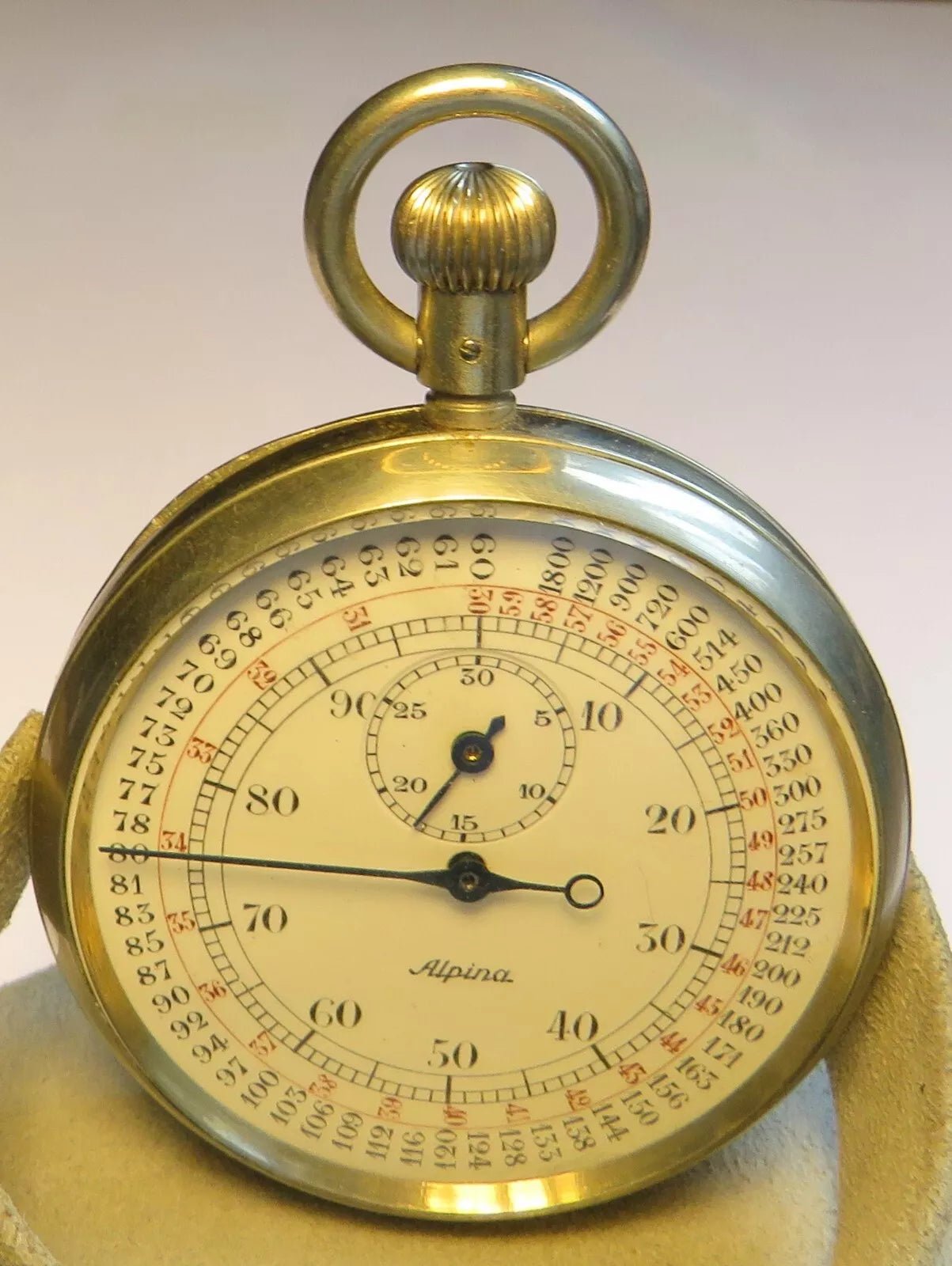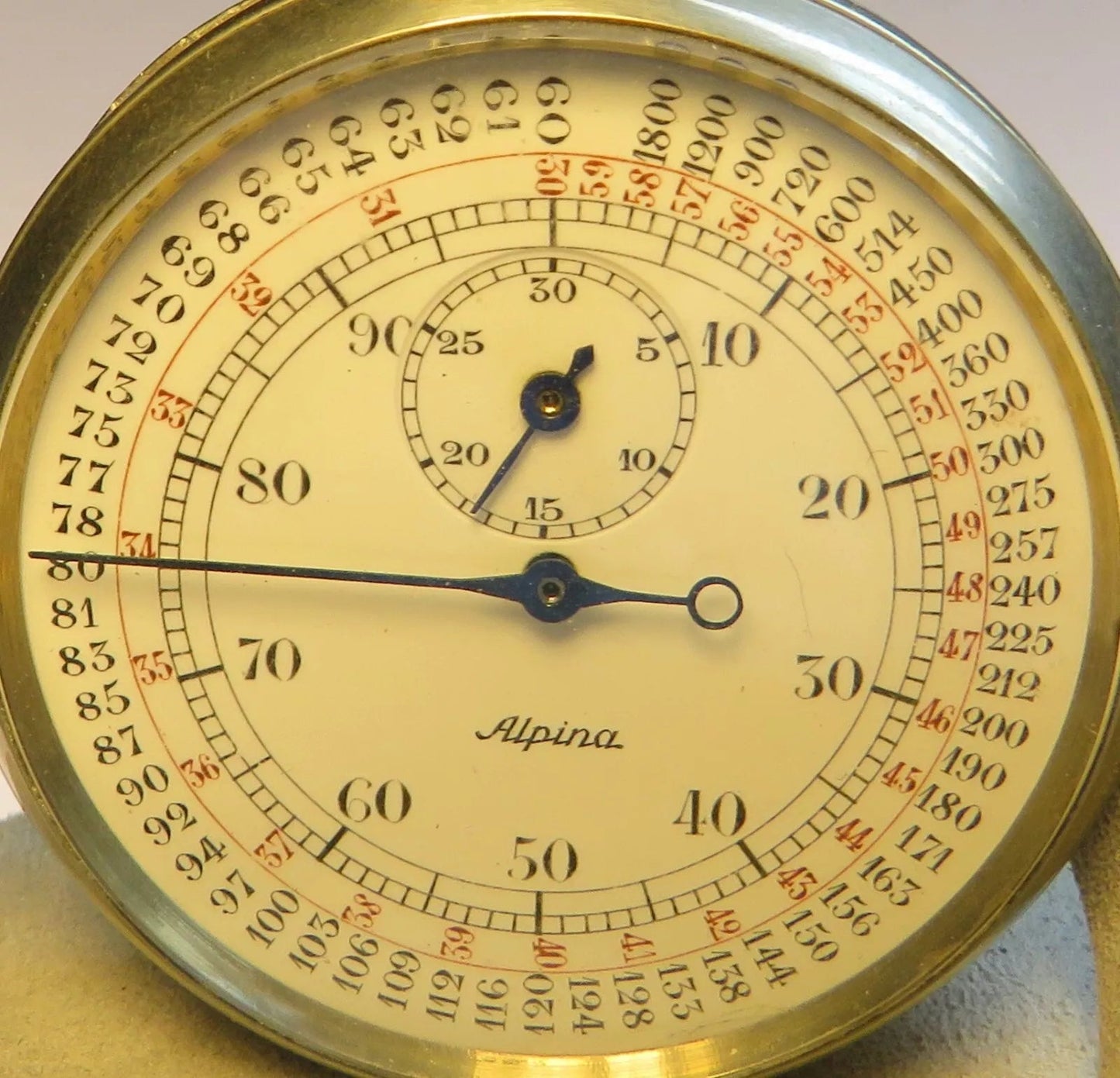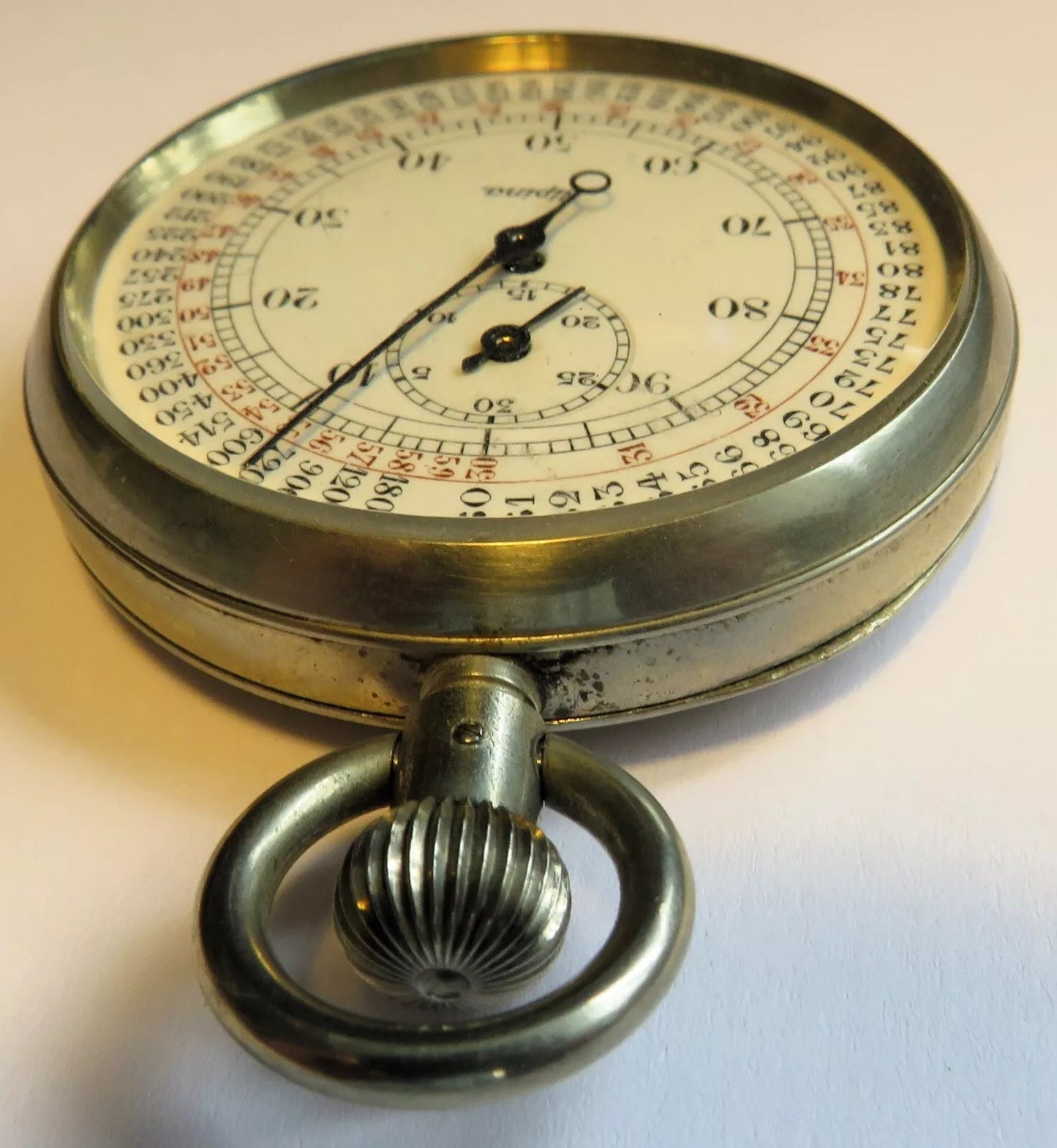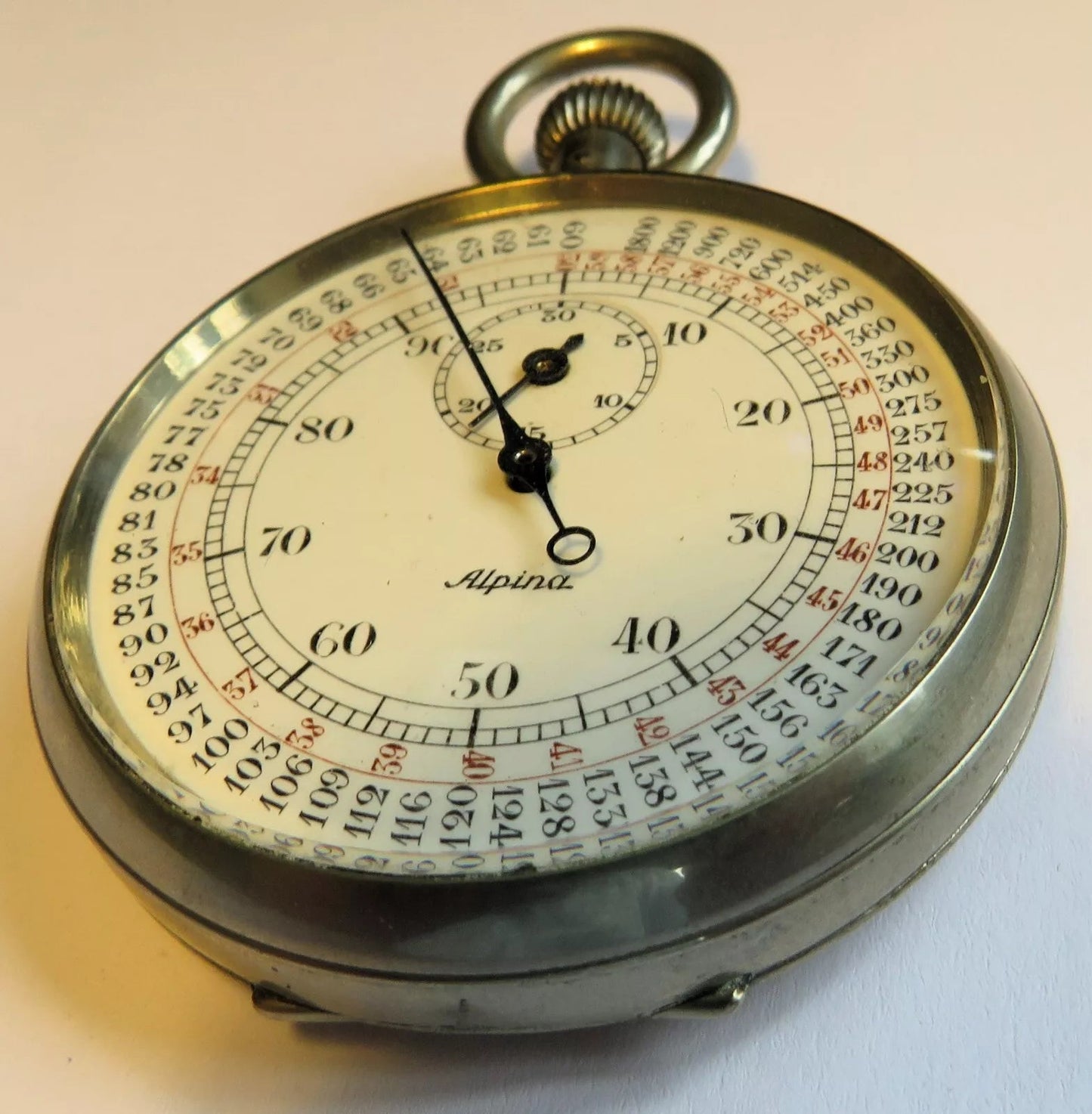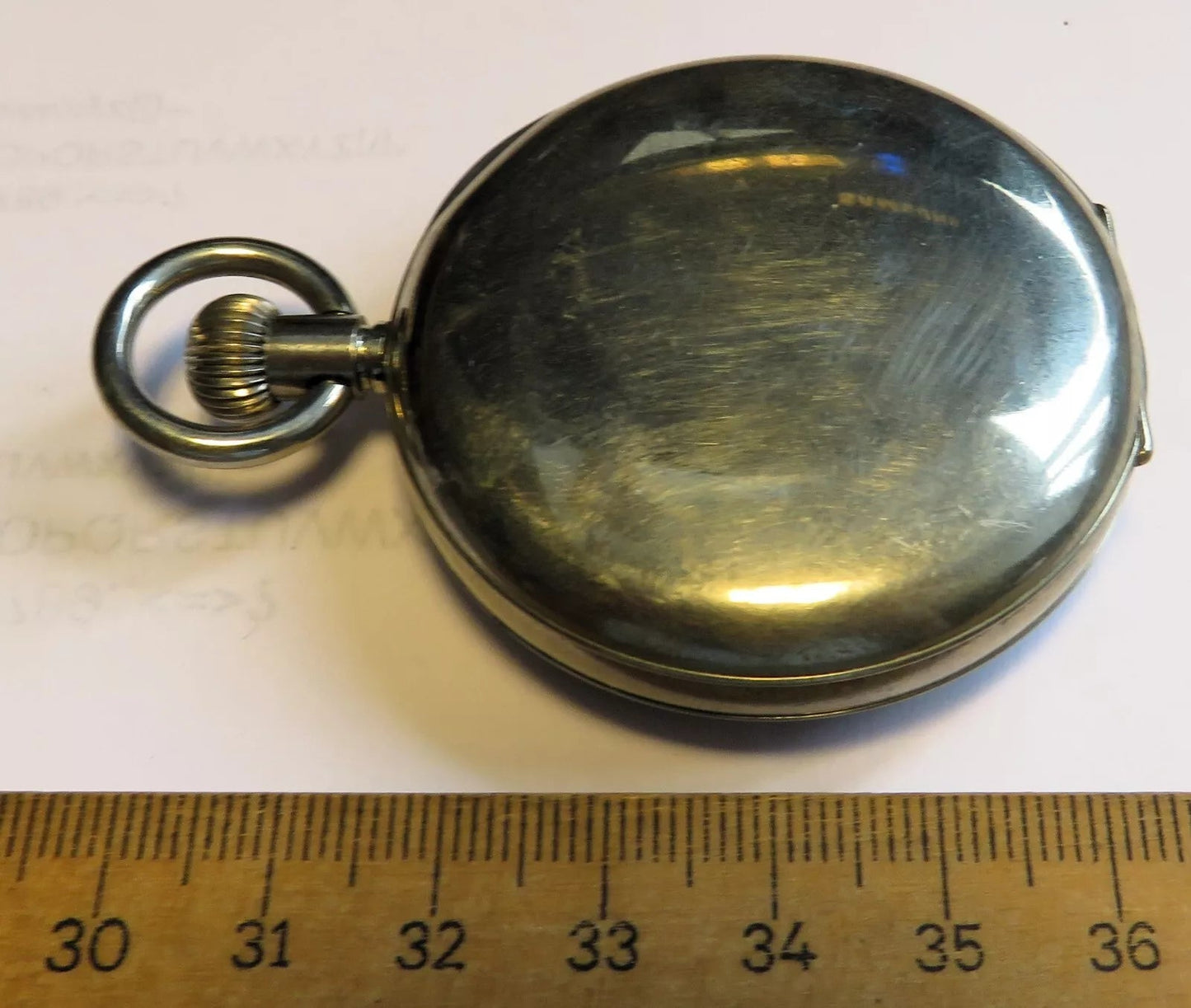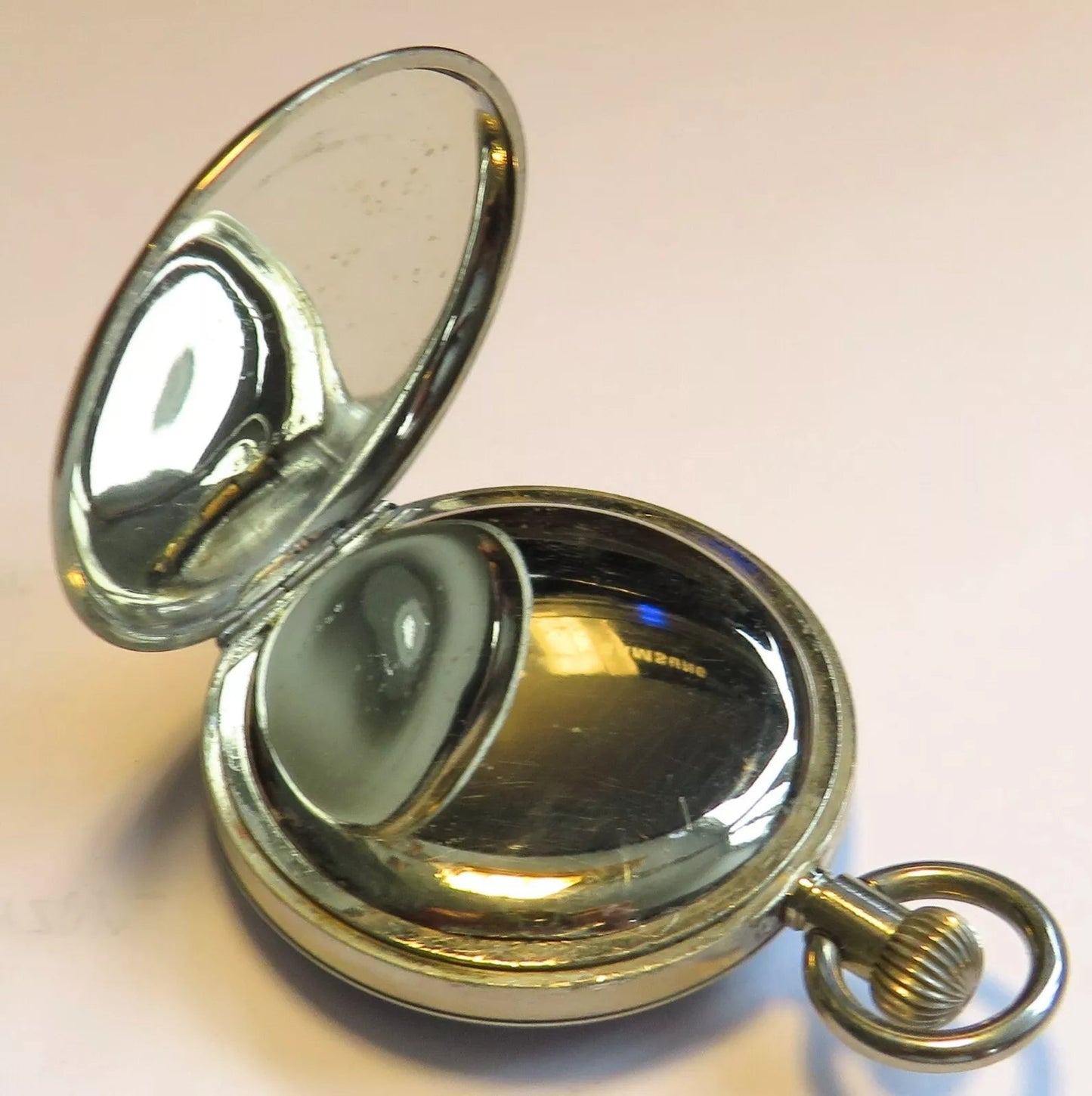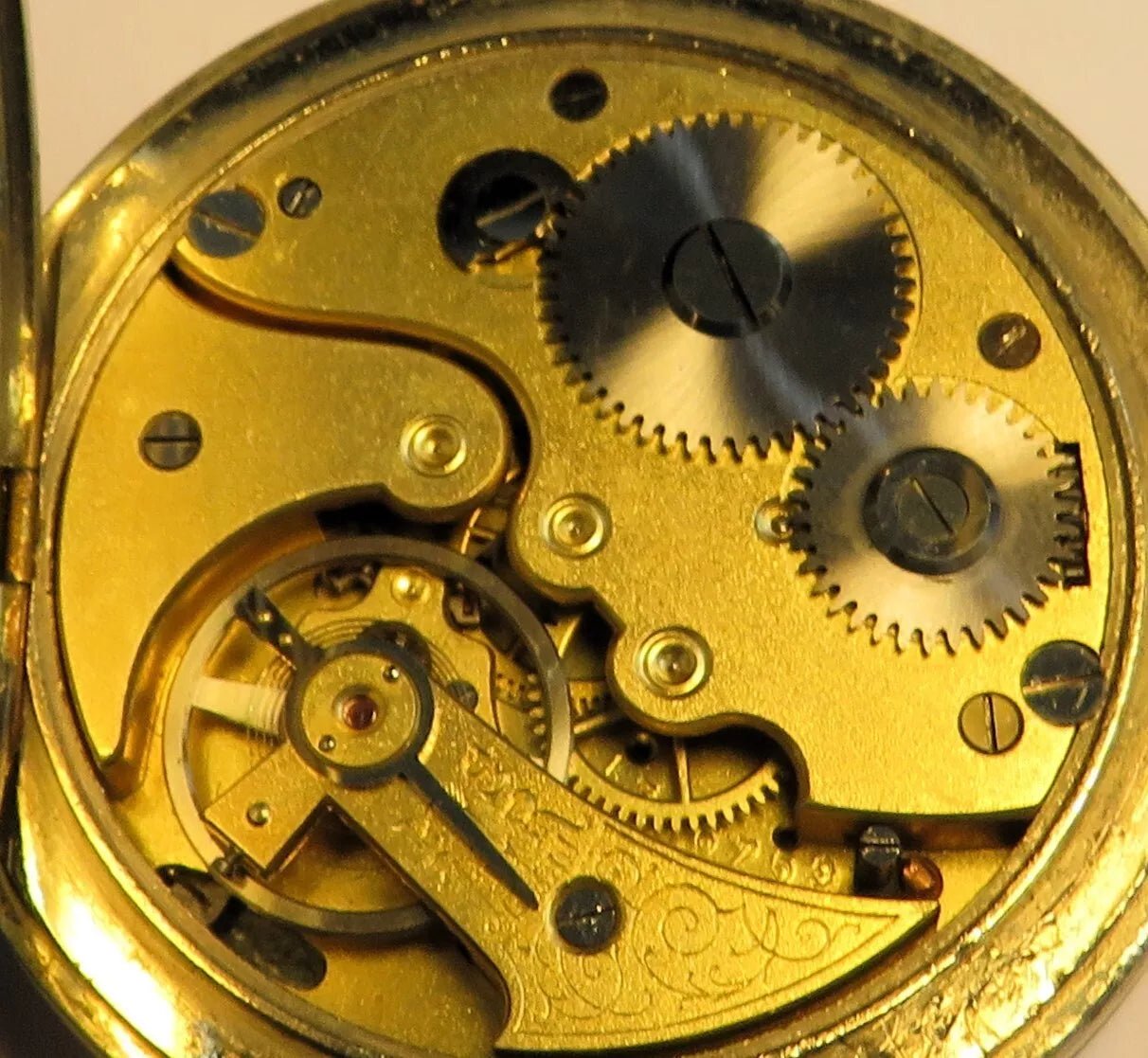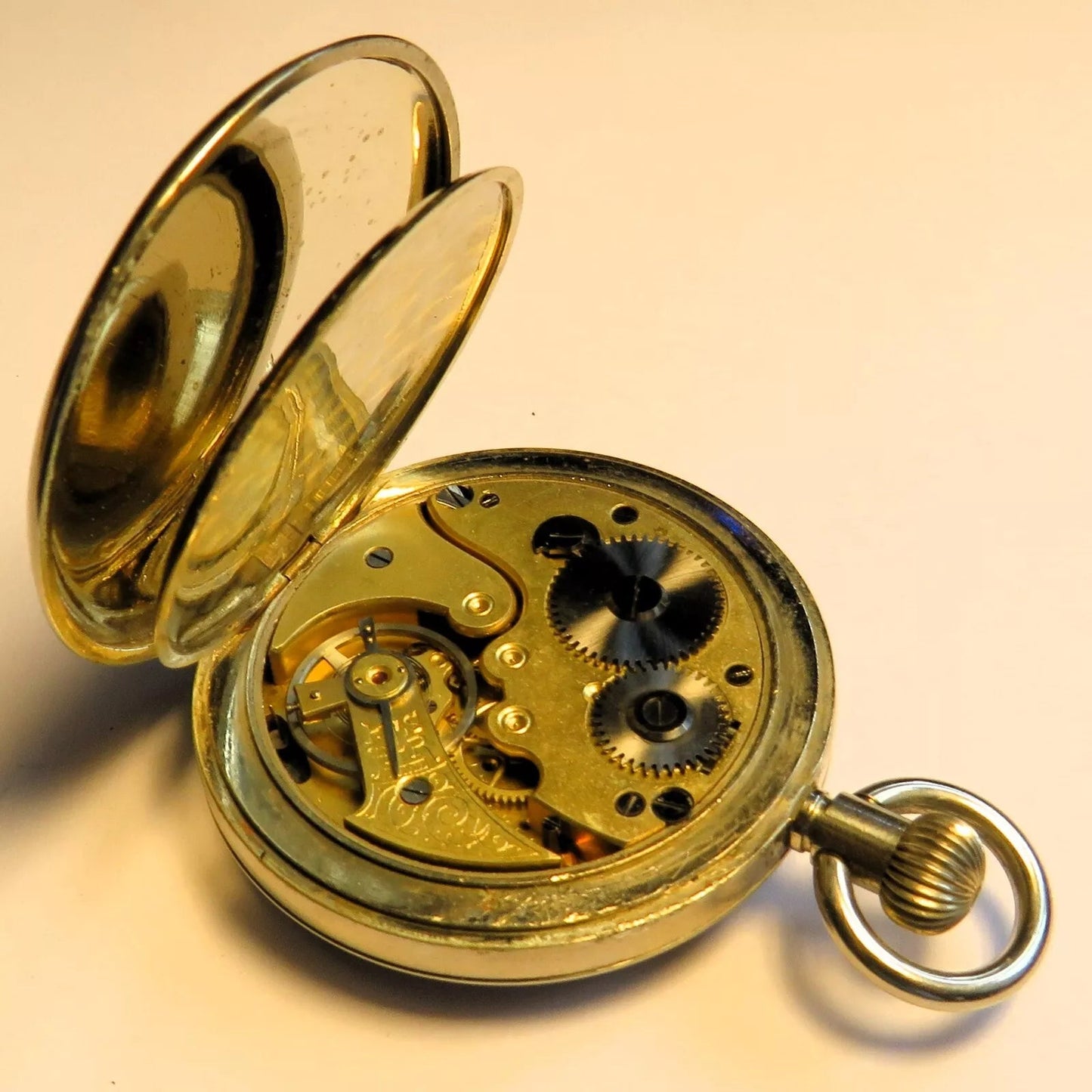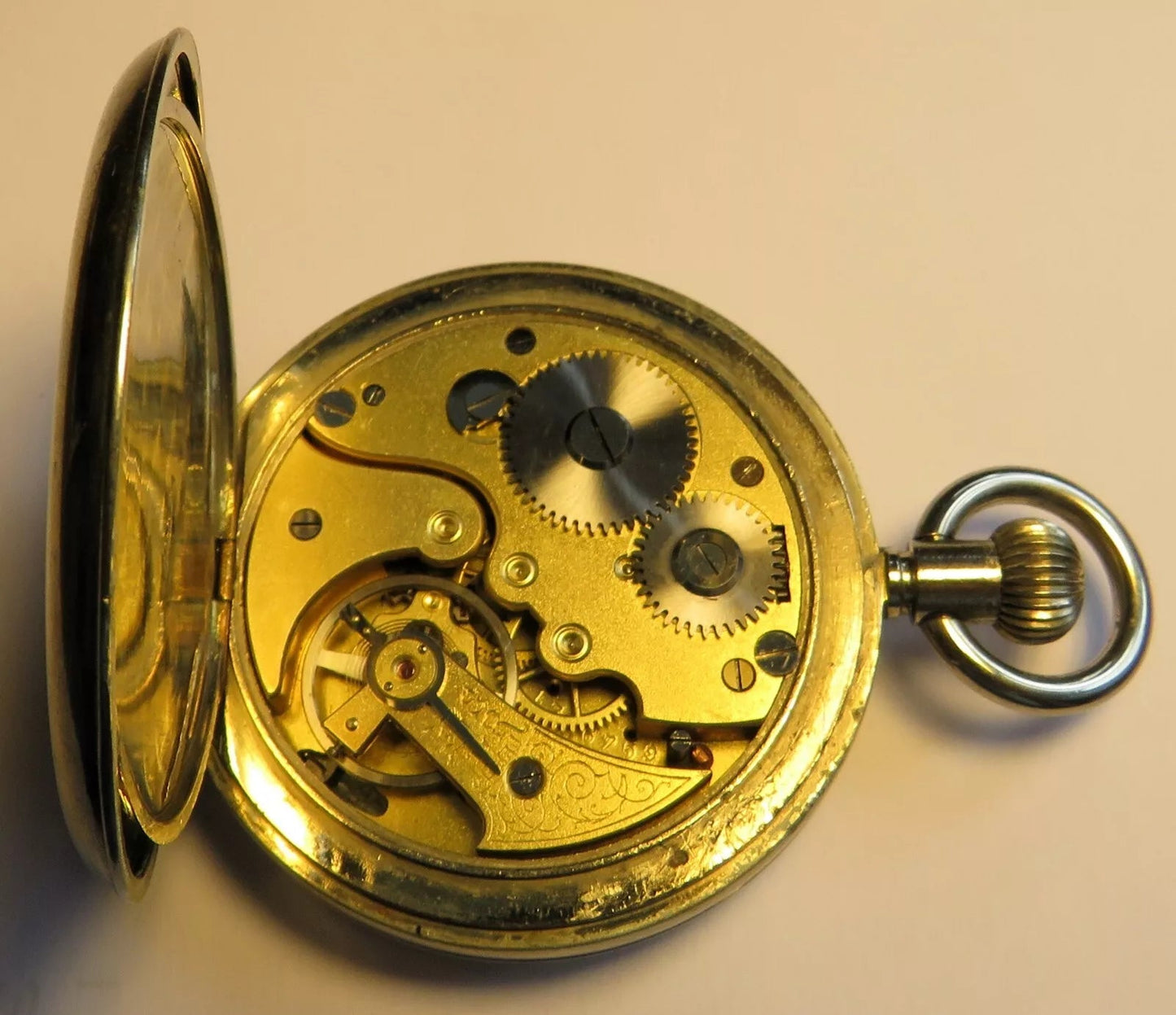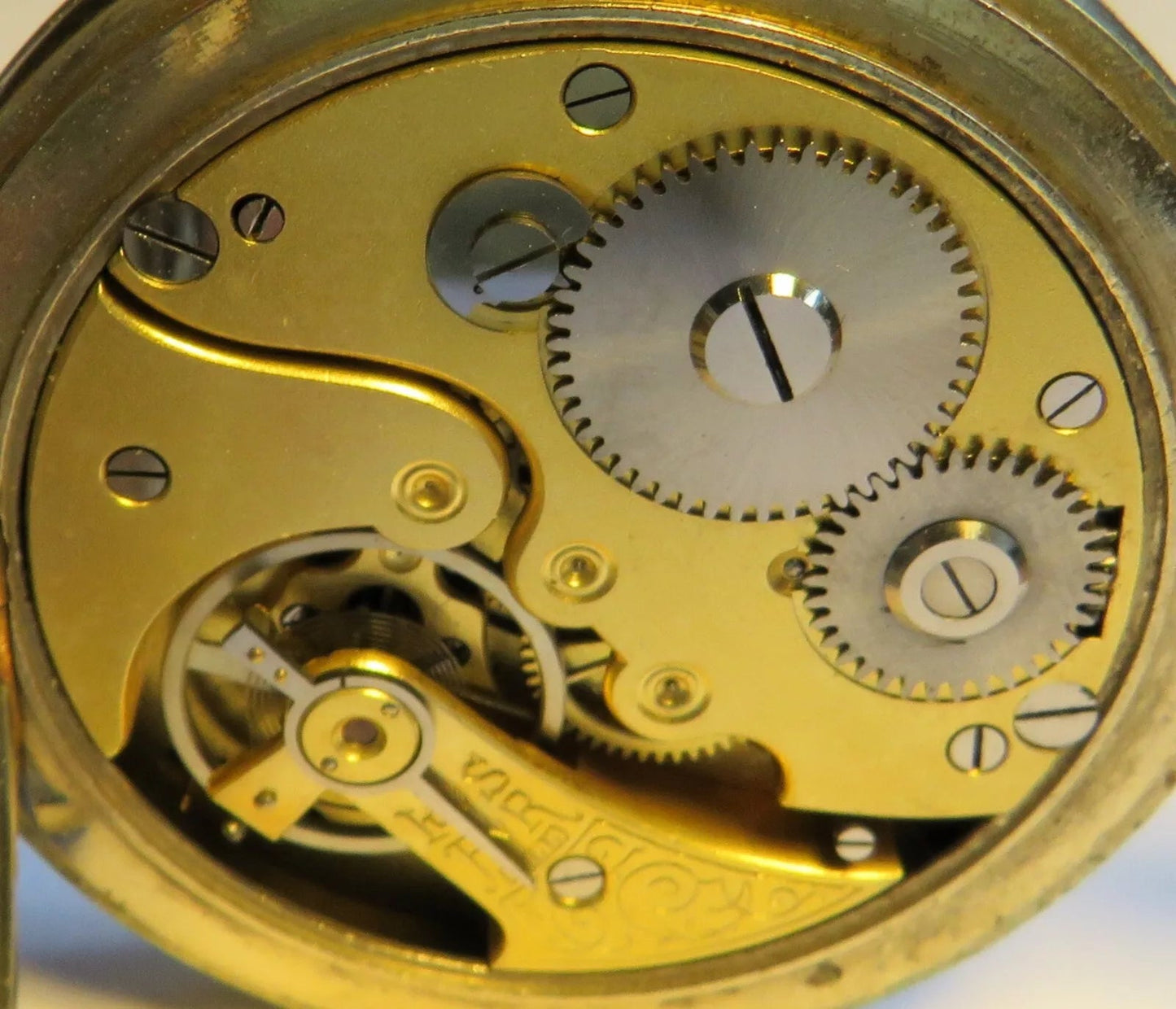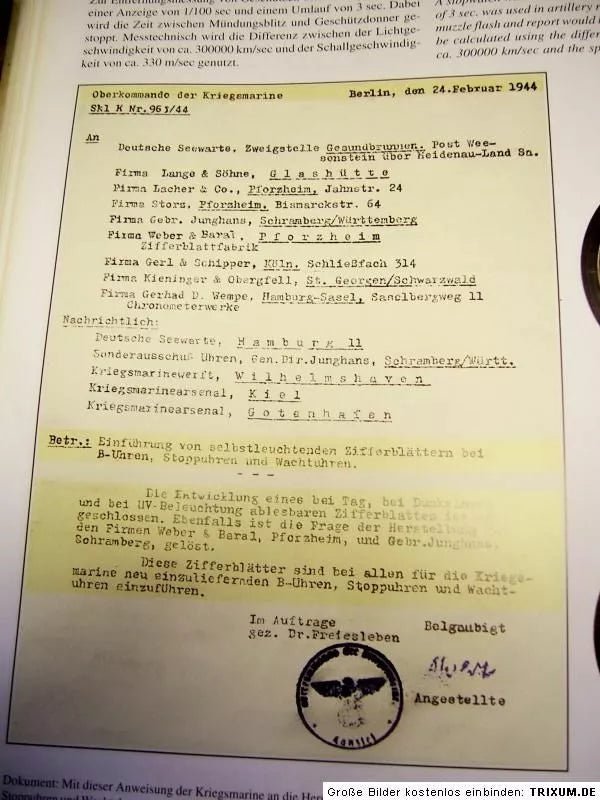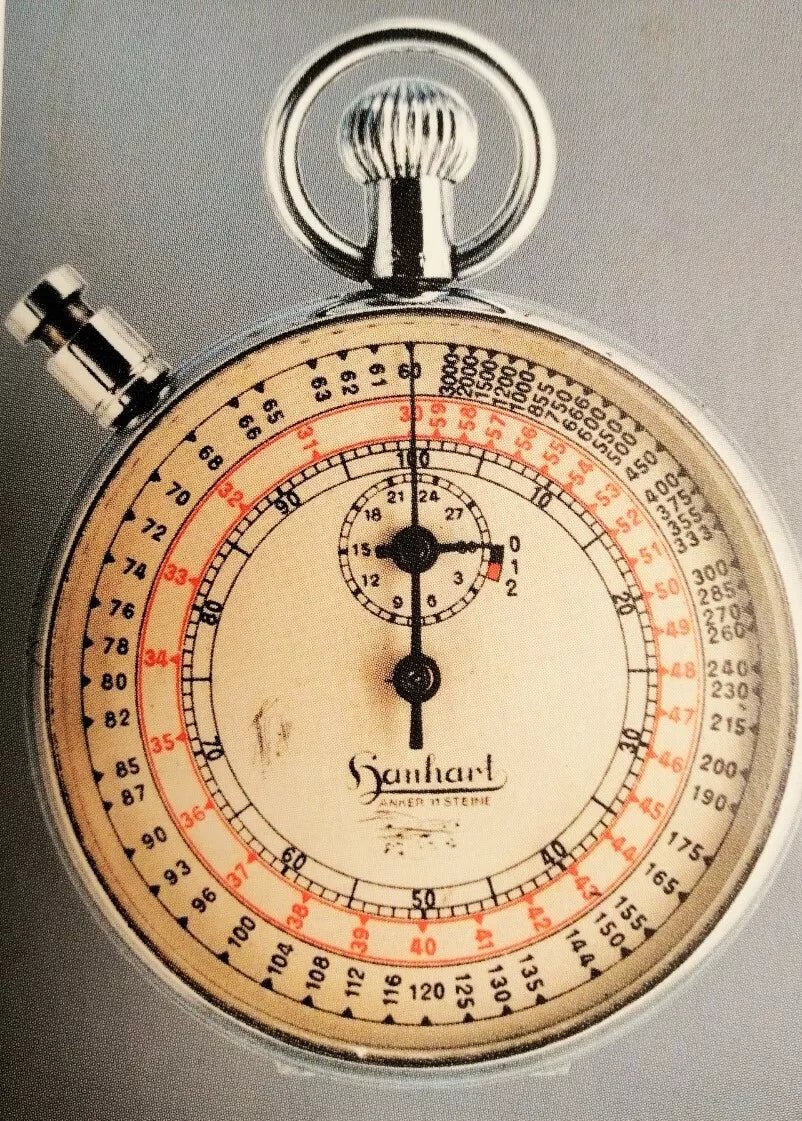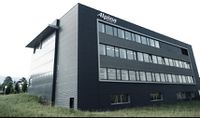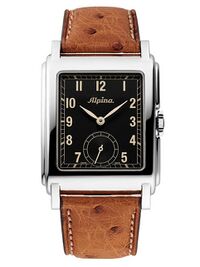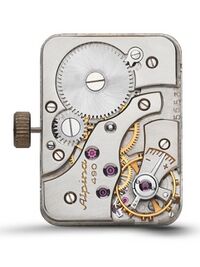Sammler-Uhren
Alpina submarine torpedo running time artillery stopwatch World War II WW2 II
Alpina submarine torpedo running time artillery stopwatch World War II WW2 II
Couldn't load pickup availability
Original Alpina extremely rare and sought-after export example of an early torpedo running time clock of the Allied forces of World War II with typical overhead indirect second and onion crown as common with the shipboard clocks of the Kriegsmarine in the late 1930s, see Knirim p. 256ff
The Swiss military and precision watch manufacturer Alpina was and is known for its extremely high-quality chronographs and stopwatches, especially before and during World War II
What makes this rare piece particularly rare and authentic is its dial, specially developed for submarine use, with a tachymeter scale precisely calibrated to the torpedoes, starting at 2,000 meters—the maximum distance of a submarine from the ship being attacked—then running down to 0 meters, the torpedo impact point. If no beep was heard on the torpedo travel time stopwatch after this time, the commander knew he had missed and needed to reload.
Above are a few sample photos of these very special Torpedo-running watches from Konrad Knirim's "Bible of Military Watches." It's clear that these also came from Junghans and Hanhart on the German side (the photos show a Hanhart with an identical dial/scale layout according to the Kriegsmarine's specifications).
A super rare piece of military and naval watch history, which only very rarely comes onto the market. Apparently, the well-known Certine / Kurth Freres watch manufacturer and supplier to the Wehrmacht in World War II built this watch, purchasing the dial and movement.
Description:
The 100% original Torpedo running time watch, stop watch has the usual dimensions for the Navy: 50mm case diameter, unrestored, best preserved, white, "Alpina" signed dial with top, indirect second, onion crown for winding as well as start and stop of the stop function
Sparkling clean, signed movement, three-lid clock, both lids close absolutely flush and rock solid
The stopwatch is fully functional! The signed movement is spotless, the case and crystal show barely any signs of age or wear, and the unrestored dial is in excellent condition.
EZ: 1 - 2, best collector's condition, dial unrestored and fully signed, flawless! Barely noticeable signs of age or wear. Winds smoothly, starts and runs continuously, accuracy not tested.
History of the Alpina (military) watch manufacturer (source: Wikipedia):
Alpina is the most important watch brand of the "Union Horlogère", a cooperative of watch manufacturers and dealers
Union Horlogère: Cooperative of watch manufacturers and dealers
The cooperative Union Horlogère was founded in 1883 by Gottlieb Hauser under the name " Swiss Watchmakers Corporation " and was based in Biel from 1890. The aim of the association of manufacturers and dealers was the cost-effective production and distribution of Watches .
The Union Horlogère began developing its own calibers and expanding its distribution network. The ebauches were produced by the Alpina ebauches factory ( Duret & Colonnaz ) in Geneva . Duret & Colonnaz also played a key role in the development of the first Alpina calibers . A branch of the Union Horlogère was located in Geneva; from 1916 , this was located at Passage de Lions 3. A branch was also opened in Besançon . On April 25, 1913 , the Union Horlogère, Swiss Watchmakers' Cooperative, Swiss Horlogère, Bienne, was registered under number 33366. (Watches, part of watches, regulators, clocks, and their packaging.)
Originally, the Alpina brand name was a caliber designation for two watch movements by J. Straub & Co. , a 12-ligne and a 19- ligne lever movement. Jacob Straub had trademarked the Alpina brand name for his watch movements. Since Straub & Co. was Union Horlogère's main supplier, practically all of Union Horlogère's watches bore the Alpina brand name. At that time, Emile Schwarz ( 1882 - March 22 , 1929 ) was a director at Alpina. As early as 1912 , the company had considered building its own home and acquiring the necessary land, but no decision was made. In 1915 , Météore SA was founded in Biel by Union Horlogère. In 1917 , the purchase of the property at Unionsgasse 13 in Biel, to which the business had since relocated, was finally considered for the first time. In 1913, August Haag was commissioned by Baugesellschaft Union AG to build a residential and commercial building at Unionsgasse 13-15 in Biel. This building is considered to be one of the finest Heimatstil buildings in the city of Biel. The purchase of the site at Unionsgasse 13 - Eisengasse 5 in Biel was discussed in detail at the Board of Directors meetings on October 17 and 25 , 1919. After difficult negotiations, the Board of Directors finally managed to agree on a purchase price of CHF 375,000 with the previous owner, Baugesellschaft Union AG in Biel (Uniongasse!). Union Horlogère was also known as Vereinigte Uhrenfabriken « Alpina » AG and « Alpina » Fabriques d'Horlogerie Réunies SA (registered February 2, 1915).
In the search for a uniform designation system, the members of the Union Horlogère agreed on:
- Alpina for all watches of the best quality,
- A (1926), Festa (1928) and Novice for watches of medium and simple quality.
Until the early 1970s, J. Straub remained the most important manufacturer for Union Horlogère. Straub also supplied movements ( Alpina 588 , 582 , 447 , and 566 to 568 , as well as P 05, P 09, P 53, and P 81 to P 85) to Rensie Watch Inc. , New York.
In December 1945 Sven Janson-Juillerat became director at Alpina, succeeding director Walter Peter . Sven had already worked for Alpina in the Biel office since 1933 and in 1938 became joint signatory with Auguste Hammel, succeeding Herbert Jeannneret . In 1945 Ulrich Klingenberg was appointed co-director alongside Sven Janson. In the 1960s the name Terval appeared alongside the name Alpina in Ebauches SA movements. The Straub hammer automatic movement was replaced by an AS movement. Ebauches SA also bought and assembled movements with a date display. In 1968 Sven Janson-Juillerat handed the reins over to younger staff, with HR Arn becoming director.
Members or suppliers of the Union Horlogère
In addition to J. Straub & Co., the following manufacturers were members or suppliers of the Union Horlogère:
- Kurth Freres, Grenchen (later Certina ) until about 1920 ,
- Duret & Colonnaz, Geneva (rough works),
- Adolf Haeker (case),
- Lesquereux & Co, La Chaux-de-Fonds , (housing and Clockworks ), Mobile Watch Co. .
- Cyma - Tavannes Watch Co. , Movements, Le Locle - Tavannes.
- Louis Bandelier & Cie , gilding, silvering and nickel plating.
- Huguenin - Robert (case),
- Ali Jeanrenaud , La Chaux-de-Fonds ( pendants , temples and gold case),
- Oskar Mistely, La Chaux-de-Fonds (decorations, guilloches and engravings),
- H. Maumary, La Chaux-de-Fonds (tension springs),
- H. Bopp-Boillot , La Chaux-de-Fonds (pointer),
- Numa Nicolet & Fils, La Chaux-de-Fonds (dials),
- Schwob Freres & Co , La Chaux-de-Fonds ( Cyma ),
- Robert Frères, Villeret ( Minerva ),
- L. Rueff & Meyrat, Saint-Imier (Alliance),
- Favre & Gindrat , 1912-1914, Besançon, Avenue Denfert Rochereau 1. R. Favre .
- Fritz Moeri, Montres Moeris , Saint-Imier .
- J. Assmann, Glashütte until 1904 for the German market.
- Météore SA subsidiary which produced radium.
The first agencies were established in Germany, Eastern, and Northern Europe. In 1901 , the name "Alpina" was registered as a trademark. In 1905 , the US companies Gruen and Hamilton joined the company. See also: Alpina Gruen Gilde SA .
In the 1920s, the following were added:
- Jules Bonnet , Biel ,
- Fabrique d'Horlogerie Montilier , Constant Dinichert junior , Montilier,
- G. Huguenin, Biel (later Hamilton ),
- Aegler, Hermann Aegler SA , Biel ( Rolex ),
- Fred and Georg Gruen, Cincinnati/Biel ( Gruen Watch ),
- Albert Weber Watch Case Factory , Geneva.
- Marc Favre & Co. Biel.
- Lavina Manufacture d'Horlogerie , Villeret.
- Ernst Böhlen-Lambelin , watch case (gold).
Presumably, the Lavina Manufacture d'Horlogerie company was also a member, because an image of the Lavina factory was used in the "Alpina Gruen Guild" advertisement. This building image closely resembles the Lavina Manufacture d'Horlogerie factory. However, buildings were sometimes depicted larger than they actually were. This factory still stands on (Rue) Le Pontins in Villeret and has never been expanded. Lavina was already collaborating with Gruen.
Over time, Alpina used movements from AS, Certina, Cyma, EB, ETA, FEF, Felsa, FHF, Frey, Gruen, Hamilton, Junghans, Landeron, Marc Favre, Minerva, Moeris, Peseux, Record, Rolex, Straub, Cyma-Tavannes, Unitas, Universal, Urofa, Valjoux and Venus, among others.
Alpina distribution network
In its 1930 yearbook, Alpina Gruen Gilde SA states that it has a distribution network of 1,575 retailers, mostly in Europe.
These were supervised by 6 country representations:
- Alpina Switzerland with 102 retailers,
- Alpina Germany with 928 retailers (e.g. Carl Oertling in Neumünster).
- Alpina Austria with 77 retailers (e.g. Paul Wagner in Vienna).
- Alpina Netherlands with 50 retailers,
- Alpina Hungary with 34 retailers and
- Alpina Denmark with 28 retailers,
Furthermore, there were Alpina dealers in the Czech Republic and Slovakia (134), in Italy (64), in Poland (32), in Spain (27), in Sweden (21), in Belgium (24), in the Balkan states (24), in Luxembourg (10), in Norway (7), in Latvia (4), in Estonia (1) and in other countries (8).
Alpina brand names
- Alpina
- Festa
- Novice
- Starliner
- Terval
Exclusively for Germany
- Artina
- Meton
- Winner
- safe
- Pretina
Errors in registered trademarks
In Karl Kochmann 's book *Clock and Watch Trademark Index: European Origin*, Aleph is listed as an Alpina trademark, registered on December 24, 1926. This name cannot be found in the original archives of the Alpina Union Horlogère, neither in the commemorative publication, nor in the caliber book, nor at the Alpina Gruen Gilde. An old Aleph pocket watch does have a caliber 1722, but this movement is not a Moeris 19- Linien D caliber, which were used for the Alpina 292 and Alpina 294 or the Alpina 1720 and Alpina 1722. Kathleen H. Pritchard mentions Albina alongside Aleph in her book *Swiss Timepiece Makers 1775-1975 *. Albina and Albinah were registered by Paul Auguste Cornioley in Fleurier on November 25 , 1912 with numbers 32290 and 32291.
Alpina Watch International
With the transformation of Alpina Union Horlogère into Alpina Watch International in 1972 , the Straub & Co. factory was closed. This marked the end of the era of producing in-house movements . The red triangle and the "Alpina" logo, which had been used for many years, also disappeared. Kurt Wanzenried , who had previously worked at the Buren Watch Company , became the new director. Heinz Labhart from St. Gallen served as representative for the Netherlands and Belgium, among other things.
We work with a number of assembly companies that exclusively process blanks , including:
- probably with Mido , Biel .
- Wyler , Biel .
- Nitella Watch Co. , Tramelan.
- Numa Jeannin Sa , Fleurier .
- Candino , Biel /Herbetswil. ( Moon phase Watches , Candino Patent)
With the development of electronic watches, a new era also began for Alpina. The first digital movements came from General Electric (USA) and the Ricoh Watch Ltd. Caliber 570 (date). The Swiss watch industry was also quickly able to meet the demand for Swiss quartz movements . The movements from Ebauches SA and Harley Ronda were the most widely used.
Unfortunately, Alpina did not escape the difficult times that plagued the Swiss watch industry in the 1970s and 1980s. The large Union Horlogere building on Uniongasse was abandoned and relocated to Silbergasse/Zentralstraße 60 (a high-rise congress building). At the beginning of the 1980s, the company moved to a much less centrally located building at Gewerbehofstraße 11. Nevertheless, like so many brands during this time, Alpina was unable to escape its difficulties. The office in Biel was closed; only in Germany did it maintain a sales office in Cologne, Montana-Uhren GmbH, at Norbertstraße 2-4.
The Alpina shares eventually passed completely into the hands of the German brothers Max and Hans Gerl. The name Alpina was still a household name among Dugena customers in Germany. After the dissolution of Dugena, opportunities were still seen for the Alpina brand. The movements used were mainly from ETA . With the comeback of mechanical ETA automatic movements , hand-wound movements ( Peseux ), and chronographs ( Valjoux ) were also added to the collection. However, in 2000 , the owners in Germany decided to withdraw the Alpina brand from the market.
Alpina in Germany
In 1899 , a German general agency ( Alpina Berlin ) was established in Berlin. At the end of 1904, J. Assmann of Glashütte withdrew from Union Horlogère because Union Horlogère's efforts to establish its own German production facility ran counter to Assmann's interests. Around 1909 , Union Horlogère founded the "Präcisions-Uhrenfabrik Alpina Glashütte GmbH" (Precision Watch Factory Alpina Glashütte GmbH) at Altenberger Str. 18 in Glashütte . Only three years later, in 1912 , did this company build the first Glashütte precision pocket watch, called the "Chronometer Alpina," with a Swiss movement and Glashütte movement parts. Starting in 1913, 21- ligne watches were also produced for the German Navy.
In 1917 , for political reasons towards the end of the First World War, the company split into Union Horlogère SA in Biel , Switzerland, and Alpina Deutsche Uhrmacher-Genossenschaft GmbH (ADUG) in Berlin, Germany. From 1935, Alpina purchased caliber 58 movements from UROFA and installed them in Alpina and Festa watches. During the Second World War, watches of the caliber 48 were also completed and regulated by Alpina Berlin . After the Second World War, the German branch of Alpina was reorganized and started anew in Darmstadt in 1949 as DUGENA , Deutsche Uhrmacher-Genossenschaft Alpina. The German Alpina was dissolved in 1972 .
Alpina in the Netherlands
In the Netherlands, the Union Horlogère was founded on April 1, 1907 , at a meeting in Utrecht. 18 watchmakers were present.
>>> Alpina Nederland (Dutch language)
The revival of the Alpina watch brand in Switzerland
Interest in the famous brand remained in Switzerland. In 2002 , the Alpina brand was acquired by Frederique Constant in Geneva from Dr. Peter Stas. The new Alpina Watches International SA moved its workshops and offices into Plan-les-Ouates, a suburb of Geneva . In 2003, Alpina was reintroduced to the market at the Basel Trade Fair with a broad range of models. The brand's image was refocused on the "spirit of mountaineering." Accordingly, the new models have a sporty and robust appearance. At the end of May 2016, Citizen acquired the Frederique Constant and Alpina brands from Dr. Peter Stas.
140 years of Alpina - 20 years of Alpina in Geneva
Company anniversaries deserve to be celebrated appropriately. This naturally also applies to Alpina. In 2023, the traditional Swiss watch brand Alpina will look back on 140 years of history. In anticipation of the 140th anniversary celebrations, the current CEO, Mr. O. Van Lanschot-Hubrecht, decided several years ago to relocate the archives and materials of the Andriessen company in the Netherlands to Geneva and preserve them there for the future. Mr. Andriessen was already involved in the creation of the first official website for the Alpina Watch International Geneva brand in 2003 , and Mr. Stass supported it with historical images and photos.
The brand celebrated the anniversary with two rectangular wristwatches with the historic hand-wound caliber 490, whose history dates back to 1938. The 28 still available examples of the 1938 movement were incorporated into two wristwatches with rectangular silver cases. They are known as the Alpina Heritage Carrée Mechanical 140 Years, with either a black or beige dial. Alpina is launching further Carrée models with the same design, but in a stainless steel case and with a modern automatic movement, known as the AL-530. Compared to the historic model, the automatic movement has shock protection and self-winding, and at 1,450 euros, the price is also significantly lower than the silver versions with the historic hand-wound movement. They were available for just under 5,000 euros, but these are now sold out. Like almost all calibers of this era, it is wound by hand, has 17 jewels, and oscillates at the reference frequency of timepieces from the 1930s, i.e. 18,000 vibrations per hour. Also noteworthy is the very high power reserve for that time (42 hours) and the very special construction of the anchor, which is greatly elongated to fit into the rectangular geometry of the caliber 490. At that time, the case was made of steel or gold, depending on the model. The steel version was protected by a patent (No. 207378). It was described as "stainless," another measure that Alpina used to protect its To make watches durable. The few surviving examples also feature a case with multiple elements that hold two seals under pressure to achieve a certain degree of water resistance. This patent has been used by several brands for the same purpose. In 2023, Alpina designed a new, tailor-made case for the Calibre 490 and named the new model after it: Heritage Carrée Mechanical 140 Years. The case is made of highly polished silver and measures 29.5 x 35.7 mm. With a minimal thickness of just 9.71 mm, it features anti-reflective sapphire crystals on both the front and back, allowing the venerable beauty of the historic Calibre 490 to be admired. The watch is worn on a light brown ostrich leather strap with white vintage stitching and a pin buckle.
